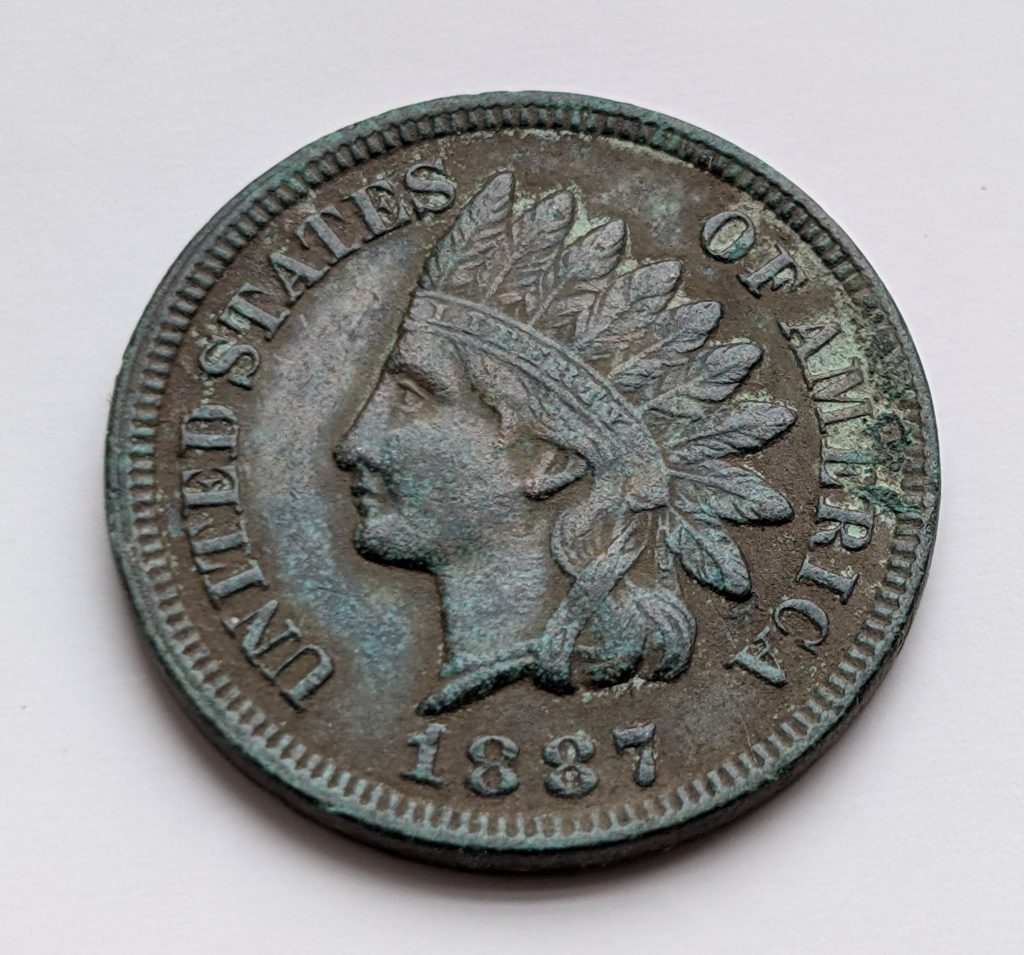What Is Coin Corrosion? Causes and Common Signs

This 1887 Indian Head Cent is fully corroded, but all the design details remain sharp — a great example of how corrosion affects surface condition without necessarily destroying definition.
Corrosion is one of the most destructive forms of damage a coin can suffer. It eats away at the surface, breaks down metal at a chemical level, and leaves behind pits, discoloration, or flaky crust that can make a coin nearly unrecognizable. Most of the time, corrosion happens when a coin is exposed to moisture, chemicals, or soil for an extended period of time. Whether it’s from being buried in the ground, stored in a damp environment, or touched with bare hands too often, corrosion is a sign that metal and the elements have been fighting. and the elements are winning.
In this post, we’ll break down what corrosion really is, what causes it, and how to tell it apart from other surface changes like toning or tarnish.
What Causes Corrosion on Coins?
Corrosion happens when a coin reacts with moisture, air, chemicals, or other environmental factors. The most common culprits are water (especially saltwater), acids from storage materials, or prolonged contact with soil or debris in the ground. Even high humidity can cause slow corrosion over time, especially on older copper coins.
This damage is fundamentally different from natural wear or circulation. Corrosion isn’t a surface imperfection from handling, it’s a chemical reaction eating into the coin itself. That’s why even uncirculated coins can show heavy corrosion if they were stored poorly.
Copper is especially vulnerable. A buried Indian Head cent can develop a green crust or splotchy surface, while silver coins might turn black, and nickels may show rough gray patches. Each metal reacts a little differently, but the process is the same: the environment attacks the metal, and the coin pays the price.
How To Spot Corrosion Before It Gets Worse
Corrosion doesn’t always show up as dramatic crusts or full-on green takeovers, it usually starts subtle. Knowing what to look for can help you catch it before the damage becomes permanent.
Here are some signs to watch for:
- Uneven texture: Corroded areas often lose the original surface texture. Instead of smooth fields or defined design details, you’ll see rough, gritty, or flaky patches — sometimes with a chalky appearance.
- Color changes: Corrosion can show up as black, gray, green, brown, or even reddish discoloration, often in splotches or streaks. These colors tend to dull the coin’s surface and lack the natural flow or beauty of toning.
- Soft edges: Raised details like lettering, dates, or rims may look melted or worn in specific spots. This isn’t from circulation, it’s because corrosion has literally eaten the metal away.
- Pitting: Tiny pits or craters in the metal surface are a clear sign of corrosion that has advanced beyond the surface. Even a lightly corroded coin might feel porous or “fuzzy” under magnification.
- Lack of luster: A coin with original mint luster won’t show corrosion in the affected areas. If you see shiny spots next to dull, rough patches, take a closer look.
Many corroded coins are still structurally sound (especially if caught early) but corrosion doesn’t stop on its own. Once the reaction starts, it keeps going unless the coin is stabilized or stored properly.
Can Corrosion Be Fixed?
This is one of the most common questions new collectors ask, and the answer is tricky. Technically, you can stop corrosion from spreading, but once metal is gone, you can’t bring it back.
Here’s the honest breakdown:
- Removing active corrosion: Yes, it’s possible to neutralize active corrosion. That means stopping the chemical reaction, drying out the coin, and creating a stable storage environment. But this process should be done carefully, and usually only on coins of low value. Most attempts to “fix” corrosion cause more harm than good.
- Restoring appearance: No. Even if you remove the corrosion, the surfaces beneath are permanently altered. The texture is usually pitted or soft, and the coin will almost always end up with a Details grade if submitted.
- Professional conservation: High-end coins with early-stage corrosion can sometimes be treated by services like NCS (Numismatic Conservation Services). These companies can stabilize the surface and prevent further damage — but it won’t make the corrosion disappear. And it’s not cheap.
The best thing you can do is catch it early, stop it from progressing, and preserve what’s left. In the next post, we’ll cover proper coin storage and how to prevent corrosion in the first place.
Final Thoughts
Corrosion can be brutal. It’s one of the few types of damage that doesn’t just affect how a coin looks, it actively eats away at the metal itself. Once it takes hold, there’s no reversing it.
But not all is lost. Learning to spot the signs early, store your coins properly, and avoid environments that promote corrosion can save you a lot of heartbreak. Even if a coin is already affected, understanding what you’re dealing with can help you decide whether it’s worth holding onto, conserving, or letting go.
Keep your eyes open, especially around the rims and protected areas. And don’t worry, we’ll go deeper into the types of corrosion and how to prevent it in the next posts.
